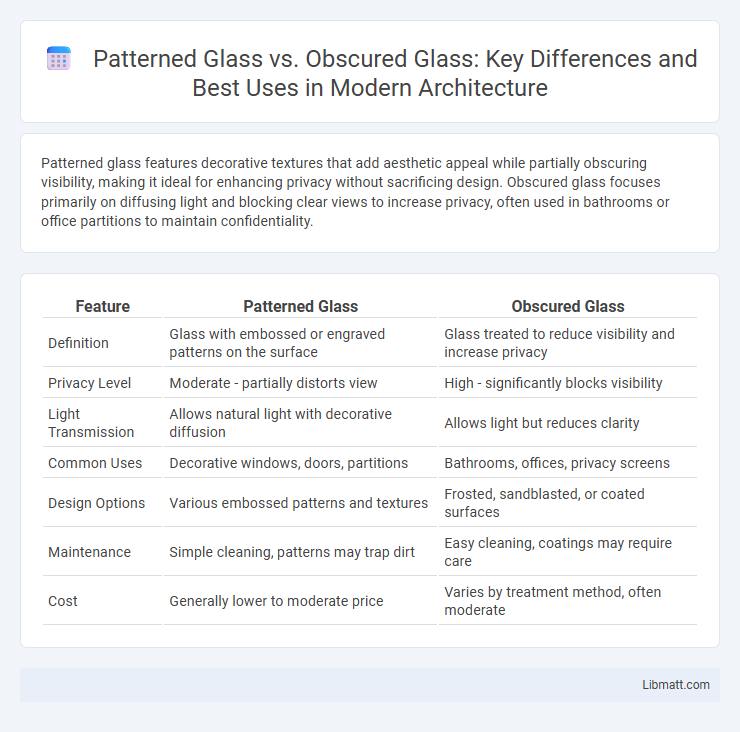Patterned glass features decorative textures that add aesthetic appeal while partially obscuring visibility, making it ideal for enhancing privacy without sacrificing design. Obscured glass focuses primarily on diffusing light and blocking clear views to increase privacy, often used in bathrooms or office partitions to maintain confidentiality.
Table of Comparison
| Feature | Patterned Glass | Obscured Glass |
|---|---|---|
| Definition | Glass with embossed or engraved patterns on the surface | Glass treated to reduce visibility and increase privacy |
| Privacy Level | Moderate - partially distorts view | High - significantly blocks visibility |
| Light Transmission | Allows natural light with decorative diffusion | Allows light but reduces clarity |
| Common Uses | Decorative windows, doors, partitions | Bathrooms, offices, privacy screens |
| Design Options | Various embossed patterns and textures | Frosted, sandblasted, or coated surfaces |
| Maintenance | Simple cleaning, patterns may trap dirt | Easy cleaning, coatings may require care |
| Cost | Generally lower to moderate price | Varies by treatment method, often moderate |
Introduction to Patterned and Obscured Glass
Patterned glass features embossed surface designs that provide decorative effects while diffusing light, making it ideal for privacy without blocking natural illumination. Obscured glass is engineered with a translucent finish or frosted texture to obscure visibility, enhancing privacy in areas like bathrooms or offices. Both types are commonly used in architectural applications to balance aesthetics, light transmission, and confidentiality.
Defining Patterned Glass
Patterned glass features intricate surface designs that create decorative effects while allowing light to pass through, providing both privacy and aesthetic appeal. Unlike obscured glass, which generally has a frosted or uniformly textured finish to block visibility, patterned glass offers varied textures and motifs that enhance interior design. Your choice depends on whether you prioritize distinctive patterns or maximum visual obstruction for privacy.
What Is Obscured Glass?
Obscured glass is designed to provide privacy by diffusing light while blocking clear visibility, making it ideal for bathrooms and office partitions. This type of glass often features a textured or frosted surface that scatters light, reducing transparency without sacrificing brightness. Unlike patterned glass, which has distinct decorative designs, obscured glass prioritizes function over form to maintain discretion in various architectural applications.
Design Features: Patterned vs Obscured Glass
Patterned glass features raised or textured designs that create visual interest and can vary from geometric shapes to intricate motifs, enhancing aesthetic appeal while maintaining partial transparency. Obscured glass employs surface treatments like sandblasting or frosting to diffuse light and obscure visibility, prioritizing privacy over decorative elements. Both types modify light transmission and visibility but patterned glass emphasizes decorative texture and design, whereas obscured glass focuses on privacy through uniform opacity.
Privacy Levels: Which Offers Better Concealment?
Patterned glass provides moderate privacy by distorting shapes and blurring visibility, making it suitable for areas requiring partial concealment. Obscured glass offers higher privacy levels by significantly diffusing light and eliminating clear views, ideal for spaces demanding maximum confidentiality. For enhanced concealment, obscured glass outperforms patterned glass in blocking detailed visibility while maintaining natural light.
Light Transmission Properties Compared
Patterned glass features textured surfaces that diffuse light, allowing moderate light transmission while reducing glare and enhancing privacy. Obscured glass typically incorporates frosted or etched finishes, scattering light more uniformly to prevent clear visibility but admitting lower light levels compared to patterned glass. Both types balance natural light entry with privacy, though patterned glass generally permits higher light transmission due to less surface opacity.
Common Applications: Where Each Type Excels
Patterned glass excels in decorative applications such as cabinet doors, shower enclosures, and partition walls, providing both privacy and aesthetic appeal through its textured designs. Obscured glass is commonly used in bathroom windows, office partitions, and exterior doors to maximize privacy while allowing natural light to filter through. Both types are chosen based on the need for privacy combined with light diffusion, with patterned glass offering more design variety and obscured glass providing consistent opacity.
Aesthetic Considerations: Visual Impact and Style
Patterned glass offers distinctive textures and intricate designs that enhance your space with decorative appeal and light diffusion, creating a dynamic visual impact. Obscured glass provides a smooth, frosted appearance that ensures privacy while maintaining a modern and minimalist style. Both options transform natural light differently, allowing you to choose based on your desired aesthetic effect and ambiance.
Durability and Maintenance Differences
Patterned glass features a textured surface that provides moderate scratch resistance, making it relatively durable but requiring careful cleaning to avoid damage. Obscured glass typically has a frosted or etched finish that withstands wear and tears better, offering easier maintenance as dirt and smudges are less visible. Your choice depends on the desired balance between aesthetic appeal and the ease of upkeep in high-traffic areas.
Cost Comparison: Patterned Glass vs Obscured Glass
Patterned glass generally costs less than obscured glass due to simpler manufacturing processes and widespread availability. Obscured glass, which often incorporates specialized coatings or treatments to enhance privacy and light diffusion, tends to have a higher price point. When budgeting for projects requiring privacy glass, choosing patterned glass can offer a cost-effective alternative without compromising on aesthetic appeal.
patterned glass vs obscured glass Infographic

 libmatt.com
libmatt.com